Memes and Misogynoir
by Laur M. Jackson
On April 7, 2012, a fire broke out at the Chateau Deville Apartments, a complex located in Oklahoma City, Oklahoma. Though no serious injuries were reported, one woman — in whose home the fire started — was treated for smoke inhalation and five units were damaged, displacing several families and depriving many more of electricity.
The story reported by NBC-affiliate KFOR-TV included a brief interview with resident Kimberly Wilkins, who ran for her life as the building as the building burned:
You probably know her better as Sweet Brown. Her closing line, “ain’t nobody got time for that,” is sure to ring a bell.
How is it that a witness to an alarming event — a fire or sexual assault — becomes one of America’s favorite punchlines, a catchphrase, that proliferates everyday vernacular so thoroughly as to make her testimony unrecognizable?

Many have used the phrase “digital blackface” to describe the odd and all-too-prevalent practice of white and non-Black people making anonymous claims to a Black identity through contemporary technological mediums such as social media. It often involves masquerading behind the Black face of a fictional profile picture. These attempts, while hilariously transparent, take advantage of the relative anonymity of the internet to perpetuate decontextualized stereotypes and project an image of Black people that fits the desire of anti-Black individuals.
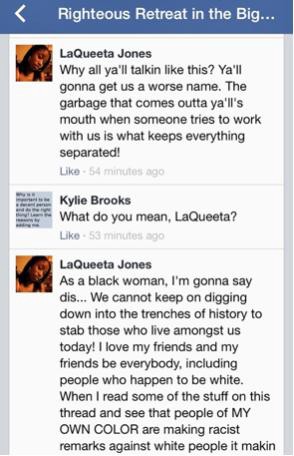
It goes undocumented and unaddressed in most cases, though occasionally the people behind the blackface are unmasked. When musician, alleged feminist, and keen event planner Ani Defranco came under censure after revealing a former slave plantation as the locale for her Righteous Retreat, a workshop for creatives, fans flocked to the event’s Facebook page in support of the gathering (and to attack its detractors), including “LaQueeta Jones.”
LaQueeta Jones’ comments include gratuitous usage of grammatically incorrect African American Vernacular English (AAVE), an evocation of MLK, and the bulletproof phrase of authenticity, “as a black woman.” An altogether weak attempt at internet minstrelsy, it prompted a skeptical Facebook user, MF Addaway, to track the IP address of “LaQueeta Jones,” and bust the actual account holder, Mandi Harrington — a white woman who had posted earlier in support of Defranco.
But most similar ventriloquism goes unchecked. On Twitter lie countless handles featuring a Black person’s image, run by users who are most assuredly not Black. These accounts, which often include a “ghetto” name — the formula prefix “La+” is a favored trope — are riddled with poor attempts at Black vernacular, and feature stereotypes from the minstrel stage. Unlike Harrington, whose contained, time-sensitive purpose was only to legitimate her own stance by replicating it with a Black voice, these users perform recyclable — retweetable — acts of humor on a worldwide stage.
After Cleveland hero Charles Ramsey became the latest in Black-people-relating-serious-events-set-to-autotune last year, Slate’s Aisha Harris scrutinized the ease with which Black interviewees — such as Ramsey, such as Brown, such as Dodson — are subject to processes of memeification. Harris’ sense, as is mine, is that the phenomenon “has something to do with a persistent, if unconscious, desire to see black people perform,” and in so doing, reaffirm a simplistic idea of what Black people are. In their memeification, Dodson and Brown were stripped of context or any possibility that these individuals could be seen as human, and reconstructed as a caricature, as farce.
In the final evolution of the meme, the soundbite falls away and ventriloquism robs these individuals of the ownership of their own words. For a good while, I don’t think a week went by without the echo of “ain’t nobody got time for that” departing from the throat of some white suburbanite in my presence. So entrenched are Sweet Brown’s words in common vernacular — much like the many, many, many appropriated hallmarks of AAVE — this particular iteration of the meme appears to have a long shelf life ahead of it. (Fortunately, “Hide your kids / Hide your wife,” seems to have truly died.)

In Righteous Discontent, Evelyn Brooks Higginbotham coined the phrase “politics of respectability” to describe the an inventive method used by women of the Black Baptist Church during the Progressive Era to gain foothold in ongoing struggles for civil rights during the Progressive Era. Thereafter abridged to “respectability politics,” Higginbotham’s concept identifies racial progressive efforts whereby the “reform of individual behavior” is in fact the “a goal in itself” as well “as a strategy for reform.” The logic of respectability politics has since morphed into thus: If we look like master and talk like master, master will stop killing us and give us the rights we deserve. If we prove ourselves worthy of a humanity, they will see us as human. Chris Rock’s “Niggas vs. Black People” bit, which appeared his 1996 HBO special Bring the Pain still remains the often-cited proverbial example of respectability political rhetoric in action — though writers often fail to include Rock’s decision to retire the bit and his later acknowledgement of its dangerous implications amongst a mixed audience. (I prefer Don Lemon as the truly insidious modern example of this logic at work.) Unlike regular, old-fashioned anti-Black racism, respectability politics operates under the guise of progress and racial uplift. Those who find faith in its dogma love to bemoan the fate of a community who considers Beyoncé a role model, chastising us all with quotes and images of MLK and Maya Angelou, conveniently forgetting that they still shot King, and Maya Angelou had moves in her day that would give Queen B a run for her money.
Respectability politics are toxic and inherently anti-Black because they blame Black people for the racism they encounter. (For those who need a primer, Loryn C. Wilson at hoodfeminism sums up the major trademarks of respectability politics and why they suck.). Respectability politics place responsibility on already extra-vulnerable segments of the Black community and claim that the very existence of these people robs the entire community of deserved human rights. And while there are no shortage of lectures railing against sagging pants and expensive sneakers, and we’re still circulating the myth that more black men occupy prisons than university classrooms, a disproportionate portion of this responsibility falls on Black women; thus, respectability politics are not only anti-Black, they are also anti-Black women.
Scholar Moya Bailey of Crunk Feminist Collective invented the term “misogynoir” to succinctly describe the anti-Black misogynist intersection of racism and misogyny that uniquely impacts the lived experiences of Black women. More than just a combination of those two oppressive regimes, misogynoir lives in a realm apart from general-use sexism — which often acts as a placeholder for strictly white women’s experiences with misogyny — and anti-Black racism that targets Black men. Misogynoir acknowledges that while white women have been fighting for the chance to prove themselves in the workplace, Black women are considered the workhorse of both white and Black America. Misogynoir explains why an eight-year-old Academy Award nominee can be called a “cunt” with nary a peep from white feminists, while Lil Wayne’s reference to Emmett Till is considered out of line, and “Rich as Fuck” makes the mainstream airwaves.
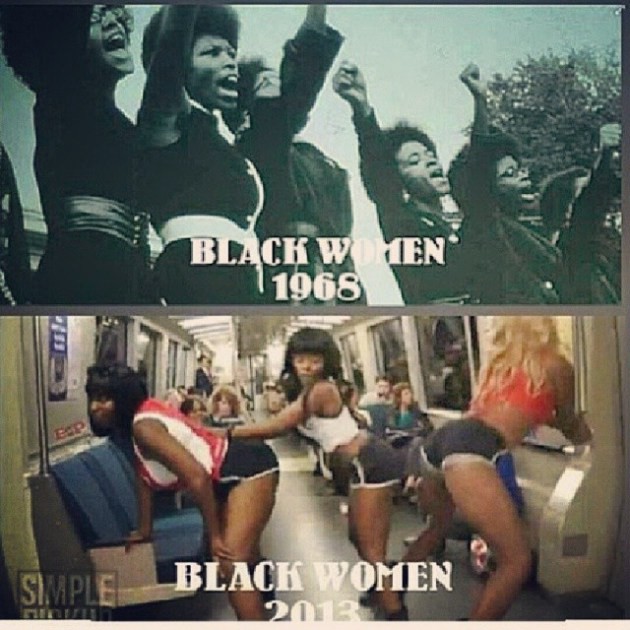
Memes and misogynoir pair together like frat boys and public urination, Chicagoland interstate and gridlock traffic, and libertarians with that sour cottage cheese smell; familiarize yourself with the former and you will inevitably encounter the latter. Many, many, many, many memes coming from Black social media spaces display misgynoir from jump. They rarely involve any kind of clever wordplay — only recognizable meme-text over a vaguely related photograph. They represent, in every way, the basest in memeified humor.
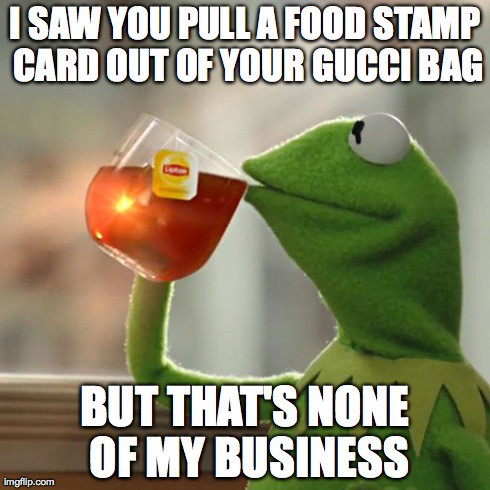
A lot of memes do originally derive their humor from good-natured sources. The recent #ButThatsNoneofMyBusiness meme — already nearly played out as I write this — began as a hilarious tribute to human pettiness. It features a photo of Kermit The Frog, pulled from Lipton’s 2014 #BeMoreTea campaign. In a reversal of Lipton’s attempt to make the imaginary experience of Kermit drinking tea resonate for real-life consumers, Black Twitter returned the character’s tea sipping back to the figurative — taking on its vernacular usage, as originally adapted by Black and brown queer communities (also “shade,” a word that in meme-like fashion has been watered down by non-queer, non-Black folks, to describe the weakest of reads). Early topics ranged from minor social contradictions to exaggerated fictional scenarios and passive aggressive divulgement of secrets. #ButThatsNoneofMyBusiness evinces beauty in subtlety — that linguistic concealment of intent, but not meaning, that Black folks have mastered as a manner of communication through centuries of enslavement and white supremacy.
As the meme ascended far past the ranks of social media obscurity (even Nicki Minaj joined the fun), frivolous grievances gave way to more sinister, more familiar tropes as the community’s favorite formula for identity-policing entered the mix. Social media proves itself over and again to be complicit in the structures that make vulnerable targets comedy’s most clutch resource; racism, transmisogyny/misogynoir, classism, ableism all pose weak barriers to a comic with dwindling material (or little talent) and participants in the meme’s circulation were not about run on empty. Unlike earlier versions of the meme, which called out bad behavior, these images lambasted those who are deemed incompatible with the wholesome picture of black respectability. The meme adopted poverty, fatness, sexual activity, government assistance, and lack of formal education as scorn-worthy topics to the response of likes, shares, and retweets from thousands. Ridicule of these markers all came together in mob pursuit of the “rachet” Black women. “Rachet,” a formally exclusive part of AAVE has of the past few years replaced “ghetto” in the anti-Black lexicon descended from Reagan’s “welfare queen,” a rhetorical myth created to leach sympathy away from Black mothers in poverty (and well, all Black people).
Black women almost exclusively bear the burden of respectability in Black social spaces online and therefore the burden of rachetness. She’s poor? She’s rachet. She has sex? She’s rachet. She has a child? She rachet. Had an abortion? Rachet. She’s a side chick and knows it? Rachet. Side chick and doesn’t know it? Rachet. Got a weave? Rachet. Has naps? Rachet. Likes to dance? Rachet. Still in high school? Rachet. Graduated high school and now works a job? Rachet. Graduated college and can’t find a job? Rachet.
We find these messages in the memes themselves. Pick a meme, any meme, conceived or co-opted by Black social media — I’ll show you a meme that worms its way toward respectability political rhetoric, with misogynoir at its core. Misogynoir is the fulcrum of anti-blackness in these memes. Take the “_____ be like” memes, which granted, were on shakier ground to begin with (we don’t need bell hooks to tell us why memes like “Niggas Be Like” or “Bitches Be Like” aren’t the most progressive). Much like #ButThatsNoneofMyBusiness, “_____ be like” takes hypocrisy as its main platform, calling out the contradiction in what people understand themselves to be and what occurs from others’ perspective.
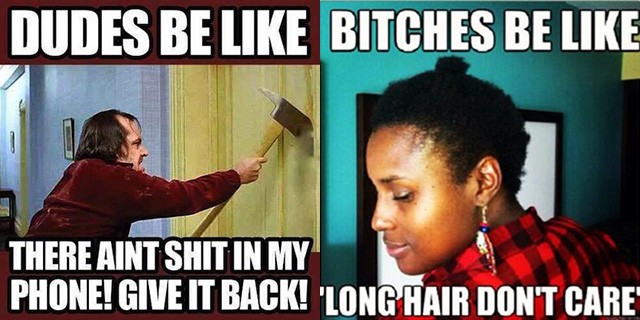
Amidst the meme’s “battle of the sexes” potential, the meme bows to respectability politics and misogynoir as users take the fill-in-blank component as opportunity to rehash the anti-Black canon.
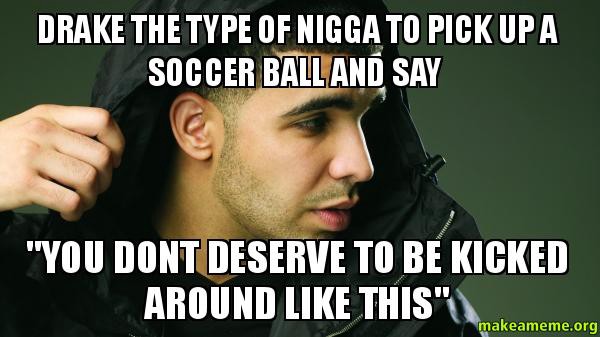
Tangential memes like “Drake be like” and “Drake the type of” take cues from the rapper’s penchant for soft beat ballads and fashion Drake into a hyperfeminized caricature. The humor derives from hypothetical Drake’s deviation from acceptable Black heteromasculinity. He treats women like friends and sisters instead of potential sex partners. He adds smilie faces to the end of his texts. He has feelings. A Black man who articulates his feelings — lol, right? The sensitive light-skin archetype appears plenty throughout meme culture, where light-skinned Black men in general are similarly memeified into inadequate pillars of manhood by virtue of an inherent lack of aggression and feminized displays of emotion. It is the misogynist and homophobic counterpart to hypermasculine and animalistic portrayals of dark-skinned individuals in memes. And it’s hardly a coincidence that the examples of memeified misogynoir throughout this piece also feature darker-skinned women.

What is the half-life of a meme? What is the rate at which a good-natured meme decays into the grossest displays public ridicule? How long until a Black feminist anthem falls prey to misgynoir’s messengers? Perhaps fault lies with the name, that the overlay of social media spectacle and
evolutionary principle
encourages us to speak of memes with a sentience external to ours.
But memeification requires participation, action, even innovation. The anti-blackness that finds refuge in memes really evinces the human existence behind the crudity of the image. And ease of sharing does not erase the responsibility of the person who chooses to do so (nor the harm this causes). Social media is not apart from the real; the internet is real-life. The misgynoir cultivated by memes manifests in the day-to-day lives of Black women who must persist in asserting their humanity within their own community. So I ask: Can we stop hating Black women?
Laur M. Jackson is a graduate student from Chicago.
